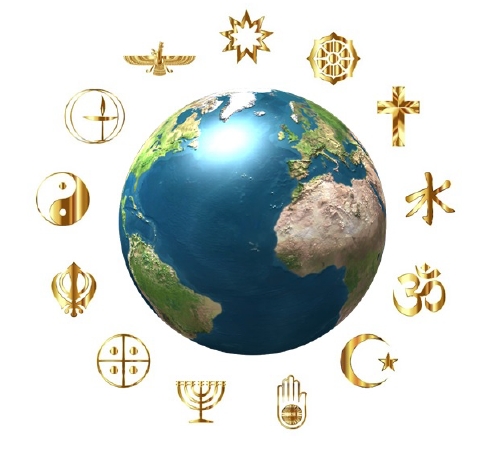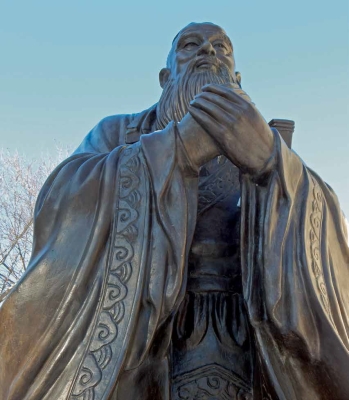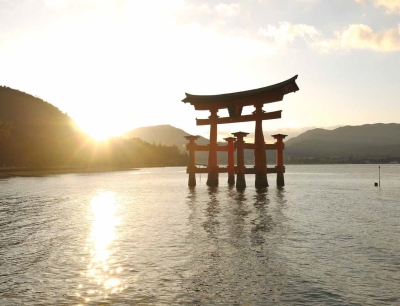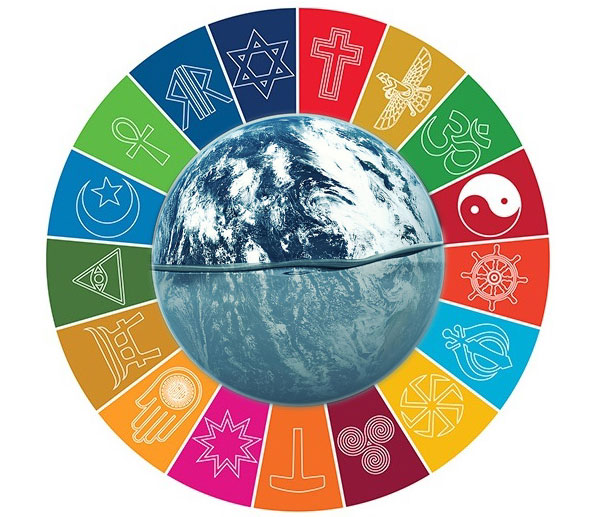 In this article, we look to what different religions have in their teachings about the origin of the Earth, the sacredness of life on Earth (including the Earth herself) and the religious imperative to care for the Earth and respect the Earth. Our faiths call us to be warriors for the sustainability and well-being of our world. The challenge is enormous, but it does not have to be daunting. No one can do all that must be done, but everyone can do something. One is not responsible for what one truly cannot do alone, but all of us are responsible for what we do together.
In this article, we look to what different religions have in their teachings about the origin of the Earth, the sacredness of life on Earth (including the Earth herself) and the religious imperative to care for the Earth and respect the Earth. Our faiths call us to be warriors for the sustainability and well-being of our world. The challenge is enormous, but it does not have to be daunting. No one can do all that must be done, but everyone can do something. One is not responsible for what one truly cannot do alone, but all of us are responsible for what we do together.
Most people are affiliated with a faith
Pew Research Center has found that more than 80 percent of the world’s population are affiliated with a faith. Such high percentage leaves no doubt that religion, and the values, behaviours and actions it entails and stipulates, have a fundamental impact on the lives of most individuals and thus on most communities worldwide. Citizens see faith-based organisations and faith leaders as trustworthy and highly networked organisations with dynamism that enables them to operate and assist in development efforts or humanitarian situations where and when needed. In many countries, religious and spiritual beliefs and practices are interwoven with cultural values, social principles, political engagement, economic prosperity and individual and group behaviours. Pew Research Center (2012), The Global Religious Landscape – A Report on the Size and Distribution of the World’s Major Religious Groups as of 2010. Washington: Pew Research Center.
Indigenous Knowledge
Indigenous knowledge is a way of thinking applied to phenomena across biological, physical, cultural, and spiritual systems. It includes insights based on evidence acquired through direct and long-term experiences and extensive and multi-generational observations, lessons, and skills. It has developed over millennia and is still developing in a living process including knowledge acquired today, and in the future, and it is passed on from generation to generation. Under this definition, it is recognised that Inuit knowledge is a way of life. It goes beyond observations, ecological knowledge, and research, offering a unique “way of knowing.” -Utqiagvik Declaration 2018, Inuit Circumpolar Council. https://www.inuitcircumpolar.com/


Judaism
The festivals of the Jewish religion do call upon us to stand before God, in awe at his majesty, trembling before His judgements, but that is not the dominant mood of the Jewish faith. The festivals celebrate, in joy, the cycle of the season of nature. The rabbis even insisted that: “He who has denied himself any one of the rightful joys of this world is a sinner” (Baba Kama 91b). The highest form of obedience to God’s commandments is to do them not in mere acceptance but in the nature of union with Him. In such a joyous encounter between man and God, the very rightness of the world is affirmed.
The encounter of God and man in nature is thus conceived in Judaism as a seamless web with man as the leader, and custodian of the natural world. Even in the many centuries when Jews were most involved in their own most immediate dangers and destiny, this universalist concern has never withered. …Now, when the whole world is in peril, when the environment is in danger of being poisoned, and various species, both plant and animal, are becoming extinct, it is our Jewish responsibility to put the defence of the whole of nature at the very centre of our concern … Man was given dominion over nature, but he was commanded to behave towards the rest of creation with justice and compassion. Man lives, always, in tension between his power and the limits set by conscience. – The Jewish Declaration on Nature: Rabbi Arthur Hertzberg, Vice President, World Jewish Congress, Assisi 1986.

Christianity
For Christians, the Hebrew Bible is part of Scripture, along with the New Testament. Selections from the Hebrew Bible that are relevant to a religious and spiritual understanding of the natural world and to environmental ethics are given in the preceding section. Below are selections from the New Testament. (All New Testament passages are from Holy Bible: New Revised Standard Version with Apocrypha.)
GOD declared everything to be good, indeed, very good. He created nothing unnecessarily and has omitted nothing that is necessary … creatures have received their mode of existence by the will of the Creator, whose purpose is that through their interdependence they should bring to perfection the beauty of the universe. It is the very nature of things considered in itself, without regard to man’s convenience or inconvenience, that gives glory to the Creator.
Man’s dominion cannot be understood as license to abuse, spoil, squander or destroy what God has made to manifest his glory. That dominion cannot be anything other than a stewardship in symbiosis with all creatures… At the risk of destroying himself, man may not reduce to chaos or disorder, or worse still, destroy God’s bountiful treasures.
Every human act of irresponsibility towards creatures is an abomination. According to its gravity, it is an offence against that divine wisdom which sustains and gives purpose to the interdependent harmony of the universe.
In his personalised relationship with all creatures, St. Francis recognised his duty to reciprocate divine love, with love and praise, not only in the name of creatures, but in, with and through them. For St. Francis, work was a God – given grace to be exercised in that spirit of faith and devotion to which every temporal consideration must be subordinate. All human effort in the world must therefore lead to a mutual enrichment of man and creatures. – The Christian Declaration on Nature: Father Langfranco Serrini, Minister General, OFM Conv., Assisi 1986.

Islam
Unity, trusteeship, and accountability, that is tawheed, khalifa, and akhrah, the three central concepts of Islam, are also the pillars of the environmental ethics of Islam. They constitute the basic values taught by the Qur’an. It is these values which led Muhammad, the Prophet of Islam, to say, “Whoever plants a tree and diligently looks after it until it matures and bears fruit is rewarded,” and “If a Muslim plants a tree or sows a field and men and beasts and birds eat from it, all of it is charity on his part,” and again, “The world is green and beautiful and God has appointed you stewards over it.” Environmental consciousness is born when such values are adopted and become an intrinsic part of our mental and physical make-up.
The notions of unity, trusteeship, and accountability should not be reduced to matters of personal piety; they must guide all aspects of life and work…They furnish us with a world-view which enables us to ask…what we can do within the ethical boundaries established by God, without violating the rights of His other creations. If we use the same values, the same understanding in our work as a scientist and technologist, economist or politician as we do to know ourselves as Muslims – those who subject themselves to the Will of God – then, I believe, we will create a true Islamic alternative, a caring and practical way of being, doing, and knowing, to the environmentally destructive thoughts and actions which dominate the world today. — The Muslim Declaration on Nature: Dr. Abdullah Omar Nasseef, Secretary General, Muslim World League, Assisi 1986.

Zoroastrianism
In Zoroastrianism, Ahura Mazda is seen as the first cause of all things Good in the universe. The universe in turn is set in accord with the concept of Asha, an ordered Truth, governed by Righteousness. In the Gathas, Zarathushtra’s sacred hymns, Ahura Mazda is seen as the Father of Asha, who has established the course of the sun, moon, and stars and upheld the earth and heavens. It is He who sustains the waters, the plants, the winds, and the clouds. He is the Creator of Light, Life, and Righteousness.
The role of mankind in the world is to serve and honour not just the Wise Lord but the Seven Bounteous Creations of the sky, water, earth, plants, animals, man, and fire—gifts of God on High to mankind on earth. In helping to bring about a state of perfection in this world and in the Seven Creations, Zarathushtra enjoined his followers to tread an ethical and righteous path.
This is only possible if one shows responsibility toward the Wise Lord’s creations. Those who perpetrate pollution and cause the defilement of all that is natural and good in the world are antithetical to the creations and to the Wise Lord Himself, as the physical world is made for the benefit of all who exist and live in the world. They must keep the Wise Lord’s world pure (pak) while living life to the fullest and participating in the goodness of the Seven Creations. — Zoroastrian Faith Statement: Prepared by the Athravan Education Trust and Zoroastrian Studies, the two main academic bodies responsible to the Zoroastrian faith for theological developments and study.

The Bahá’í Faith
Nature in its essence is the embodiment of My Name, the Maker, the Creator. Its manifestations are diversified by varying causes, and in this diversity there are signs for men of discernment. Nature is God’s Will and is its expression in and through the contingent world. It is a dispensation of Providence ordained by the Ordainer, the All-Wise.”
With those words, Bahá’u’lláh, Prophet-Founder of the Bahá’í Faith, outlines the essential relationship between man and the environment: that the grandeur and diversity of the natural world are purposeful reflections of the majesty and bounty of God. For Bahá’ís, there follows an implicit understanding that nature is to be respected and protected, as a divine trust for which we are answerable.
A century ago, Bahá’u’lláh proclaimed that humanity has entered a new age. Promised by all the religious Messengers of the past, this new epoch will ultimately bring peace and enlightenment for humanity. To reach that point, however, humankind must first recognise its fundamental unity as well as the unity of God and of religion. Until there is a general recognition of this wholeness and interdependence, humanity’s problems will only worsen.
“The wellbeing of mankind, its peace and security, are unattainable unless and until its unity is firmly established,” Bahá’u’lláh wrote. “The earth is but one country, and mankind its citizens.”
For Bahá’ís the goal of existence is to carry forward an ever-advancing civilisation. Such a civilisation can only be built on an earth that can sustain itself. The Bahá’í commitment to the environment is fundamental to our Faith. — The Bahá-í Faith Statement on Nature: Presented in October 1987, when the Bahá-í Faith became the sixth religion to join the Network on Conservation and Religion.

Hinduism
Not only in the Vedas, but in later scriptures such as the Upanishads, the Puranas, and subsequent texts, the Hindu viewpoint on nature has been clearly enunciated. It is permeated by a reverence for life, and an awareness that the great forces of nature — the earth, the sky, the air, the water and fire — as well as various orders of life including plants and trees, forests and animals are all bound to each other within the great rhythms of nature. The divine is not exterior to creation, but expresses itself through natural phenomena.
According to Vaishnava tradition, the evolution of life on this planet is symbolised by a series of divine incarnations beginning with fish, moving through the amphibious forms and mammals, and then on into human incarnations. This view clearly holds that man did not spring fully formed to dominate the lesser life forms, but rather evolved out of these forms, and is therefore integrally linked to the whole of creation.
The Hindu tradition of reverence for nature and all forms of life, vegetable or animal, represents a powerful tradition which needs to be re-nurtured and reapplied in our contemporary context.
Let us declare our determination to halt the present slide towards destruction, to rediscover the ancient tradition of reverence for all life and, even at this late hour, to reverse the suicidal course upon which we have embarked. Let us recall the ancient Hindu dictum – “The Earth is our mother, and we are all her children.” — The Hindu Declaration on Nature: Dr. Karan Singh, President, Hindu Virat Samaj, Assisi 1986.

The Jain Religion
The Jain ecological philosophy is virtually synonymous with the principle of ahimsa (non-violence) which runs through the tradition like a golden thread.
Ahimsa (non-violence) is a principle that Jains teach and practice not only towards human beings but towards all nature. It is an unequivocal teaching that is at once ancient and contemporary.
There is nothing so small as the atom nor any element so vast as space. Similarly, there is no human quality more subtle than non-violence and no virtue of spirit greater than reverence for life.
The teaching of ahimsa refers not only to physical acts of violence but also to violence in the hearts and minds of human beings, their lack of concern and compassion for their fellow humans and for the natural world. Ancient Jain texts explain that violence (himsa) is not defined by actual harm, for this may be unintentional. It is the intention to harm, the absence of compassion, that makes an action violent. Without violent thought there could be no violent actions.
Jain cosmology recognises the fundamental natural phenomenon of symbiosis or mutual dependence. All aspects of nature belong together and are bound in a physical as well as metaphysical relationship. Life is viewed as a gift of togetherness, accommodation, and assistance in a universe teeming with interdependent constituents. —The Jain Declaration on Nature: Dr. L. M. Singhvi, prepared for the Institute on Jainology and presented on the occasion of the entry of the Jain faith into the Network on Conservation and Religion, London 1990.

Buddhism
The Ordination of Trees
In the early 1990s “ecology monks” in Thailand’s environmental movement began to wrap orange cloth around trees in a ceremony modeled on the ordination of a Buddhist monk, with full use of Buddhist symbols and participation by local villagers. Ordination makes the tree sacred and draws attention to the importance of trees and the urgent need to prevent deforestation. Many ordained trees bear a sign “To destroy the forest is to destroy life.” The tree ordination movement has spread from Thailand to other countries including Cambodia, Laos, and Sri Lanka. As many as 1,000 trees have been ordained in one ceremony.
A major aim of Buddhism is to relieve suffering, the root causes of which are greed, ignorance, and hatred. The monks see the destruction of the forests, pollution of the air and water, and other environmental problems as ultimately caused by people acting through these evils, motivated by economic gain and the material benefits of development, industrialization, and consumerism. As monks, they believe it is their duty to take action against these evils. — Susan M. Darlington, “The ordination of a tree: The Buddhist ecology movement in Thailand,” Ethnology Vol. 37, No. 1, p. 1.

The Sikh Religion
We are called to the vision of Guru Nanak, which is a World Society comprising God-conscious human beings who have realized God. To these spiritual beings the earth and the universe are sacred; all life is unity, and their mission is the spiritualization of all.
Guru Nanak in his philosophy states that the reality that humans create around themselves is a reflection of their inner state. The current instability of the natural system of the earth—the external environment of human beings—is only a reflection of the instability and pain within humans. The increasing barrenness of the earth’s terrain is a reflection of the emptiness within humans.
This environmental crisis cries out for an immediate and urgent solution. It requires going back to the basic question of the purpose of human beings in this universe and an understanding of ourselves and God’s creation.
The solution to problems manifest in our world lies in prayer and in accepting God’s hukam. It is difficult to translate certain Sikh concepts accurately. Hukam is one such concept— it may be best described as a combination of God’s will, order, and system. With an attitude of humility, and surrender to the Divine Spirit, conscientious human beings can seek to redress the current crises of the environment and of social justice. In the Sikh Way this is done through the guidance of the Guru, who is the Divine Master and messenger of God. — Compiled under the guidance of Sri Singh Sahib Manjit Singh, the Jathedar of Anandapur, one of the five spiritual and temporal heads of The Sikh Religion, and Sri Akhal Takhat Sahib, his deputy.

Confucianism
Confucianism sees its primary role to be the promotion of education designed to enable people to become truly human. Its purpose is the cultivation of a virtuous, responsible and caring person. Learning to be genuinely and fully human is an end in itself. Simultaneously it is also a dynamic and transformative process of self-realization, social engagement and cultural creativity … This process is set within the greater context of humanity and Heaven … Confucianism sees humankind to have a deep and cosmic significance. This significance manifests itself in partnership with both Heaven and Earth, forming the classic Chinese trinity of Heaven, Earth and Humankind, together manifesting the true embodiment of nature itself.
Confucians know that the earth is alive. We observe its presence, appreciate its beauty and participate in its creativity. We therefore share its richness and fecundity with all life on the “Blue Planet” .. However, humanity has repeatedly abused this beautiful gift by exploiting it recklessly, ignoring the Confucian notion of balance and harmony … This world is a precious heritage passed on to us from our ancestors and it is a resource entrusted to us by numerous generations yet to come … The sense of “awe and reverence before the universe” is prompted by our aspiration to respond to the ultimate reality that makes our lives purposeful and meaningful. Whether we come from a creationist or evolutionist perspective, we are indebted to “Heaven, Earth and the myriad things” for our existence. To repay this debt we cultivate ourselves so as to attain our full humaneness amidst the wonder of existence. — Confucian Statement on Ecology: Professor Tu Weiming for the International Confucian Ecological Association, on the occasion of Confucianism joining the Alliance of Religion and Conservation in 2013.

Daoism
There are four main principles that should guide the relationship between humanity and nature:
1. In the Dao De Jing (Tao Te Ching), the basic classic of Daoism, there is this verse: “Humanity follows the Earth, the Earth follows Heaven, Heaven follows the Dao, and the Dao follows what is natural.” This means that the whole of humanity should attach great importance to the Earth and should obey its rule of movement…
2. In Daoism, everything is composed of two opposite forces known as Yin and Yang. Yin represents the female, the cold, the soft and so forth; Yang represents the male, the hot, the hard and so on. The two forces are in constant struggle within everything. When they reach harmony, the energy of life is created. From this we can see how important harmony is to nature.
3. People should take into full consideration the limits of nature’s sustaining power, so that when they pursue their own development, they have a correct standard of success. If anything runs counter to the harmony and balance of nature, even if it is of great immediate interest and profit, people should restrain themselves from doing it.
4. Daoism has a unique sense of value in that it judges affluence by the number of different species. If all things in the universe grow well, then a society is a community of affluence. If not, this kingdom is on the decline. — The Daoist Faith Statement: The Chinese Daoist Association.
The Way is the origin of all things — the Mother of Heaven and Earth. It is also the right pattern and the spontaneous, effective functioning of everything in nature. The Dao nourishes life and the balance of Yin and Yang. A person with full knowledge of the Dao is a Sage or enlightened person. Daoism gives the highest importance to living in accord with the order of nature and the virtues of simplicity, restraint, and humility. Daoists today seek to apply their ancient value system to engage contemporary environmental problems.

Shinto
In the beginning of the universe there appeared various Kami, or deities, from the chaos. A pair of male and female deities appeared at the end and gave birth first to the islands, their natural environment, and then to several more deities who became ancestors of the Japanese. The ancient Japanese considered that all things of this world have their own spirituality, as they were born from the divine couple. Therefore, the relationship between the natural environment of this world and people is that of blood kin, like the bond between brother and sister. Shinto regards that the land, its nature, and all creatures including humans are children of Kami. Accordingly, all things existing on this earth have the possibility of becoming Kami.
An agricultural society based on rice cultivation like that of Japan cannot exist without unification and harmony among all things on this earth: mountains, rivers, the sun, rain, animals, and plants, not to mention cooperation among people … This gave rise to the spirit of revering various Kami, the land, nature, people, and, on top of that, the spirit of appreciation of harmony among all these aspects of Nature.
Environmental issues depend on our self-awareness of the problems and our determination to take responsibility … Shinto suggests that we should shift our point of view and look at our environment with the spirit of “reverence and gratitude,” that is, with the spirit of parental care for children or with the spirit of brotherhood. —Prepared by the Jinja Honcho, the representative body of all Shinto Shrines in Japan.
Understanding Climate Change
Earth’s climate is now changing faster than at any point in the history of modern civilisation, primarily as a result of human activities.
Thousands of studies conducted by researchers around the world have documented increases in temperature at Earth’s surface, as well as in the atmosphere and oceans. Many other aspects of the global climate are changing as well. Human activities, especially emissions of heat-trapping greenhouse gases from fossil fuel combustion, deforestation, and changes in land use, are the primary drivers of the climate changes observed in the industrial era… The atmospheric concentration of carbon dioxide, the largest contributor to human-caused warming, has increased by about 40% over the industrial era. This change has intensified the atmosphere’s natural greenhouse effect, driving an increase in global surface
temperatures and other widespread changes in Earth’s climate that are unprecedented in the history of modern civilization. —from U. S. Global Change Research Program. https://www.globalchange.gov/climate-change

Download this page as PDF file
© Saieditor.com
![]()

